Lista över organismer efter antal kromosomer
Utseende
| Den här listan är ofullständig, du kan hjälpa till genom att utöka den. |
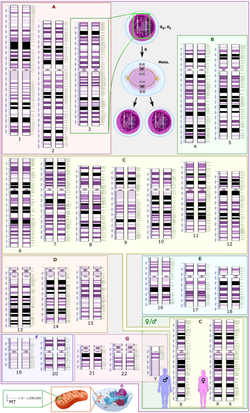

Detta är en lista över organismer efter antal kromosomer som beskriver ploiditet eller antalet kromosomer i cellerna av olika växter, djur, protister och andra levande organismer. Detta antal, tillsammans med det visuella utseendet av kromosomen, är känt som karyotypen,[2][3][4] och kan hittas genom att titta på kromosomerna med ett mikroskop. Uppmärksamhet riktas mot deras längd, centromerernas position, bandingmöster, eventuella skillnader mellan könskromosomerna och andra fysiska egenskaper.[5] Framställning och studier av karyotyper är en del av cytogenetik.
Djur
Växter
Svampar
Protister
Arkéer
Bakterier
| Organism | Bild | Latin | Kromosomer | Anmärkning |
|---|---|---|---|---|
| Jack Jumper |  |
Myrmecia pilosula | 2[6] | 2 för honor, hanar är haploida och har därmed 1; minsta möjliga antal. Andra myrarter har fler kromosomer.[6] |
| Indisk muntjak |  |
Muntiacus muntjak | 6/7 | 6 för honor, 7 för hanar |
| Korn |  |
Hordeum vulgare | 14[7] | |
| Råg |  |
Secale cereale | 14[7] | |
| Ärt |  |
Pisum sativum | 14[7] | |
| Koala |  |
Phascolarctos cinereus | 16 | |
| Känguru | 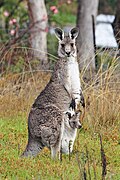 |
16 | Detta inkluderar flera medlemmar släktet Macropus, men inte den röda jättekängurun (M. rufus, 20)[8] | |
| En |  |
Juniperus communis | 22[7] | |
| Gran |  |
Picea abies | 24[7] | |
| Tall |  |
Pinus sylvestris | 24[7] | |
| Vårtbjörk |  |
Betula pendula | 28[7] | |
| Jäst |  |
Saccharomyces cerivisiae | 32 | |
| Blåsuga |  |
Ajuga pyramidalis | 32[7] | |
| Rödräv |  |
Vulpes vulpes | 34[källa behövs] | Plus 3–5 mikrosomer. |
| Katt |  |
Felis silvestris catus | 38 | |
| Lejon |  |
Panthera leo | 38 | |
| Mård |  |
Martes martes | 38 | |
| Tiger |  |
Panthera tigris | 38 | |
| Hyena |  |
Hyaenidae | 40 | |
| Fossa |  |
Cryptoprocta ferox | 42 | |
| Järv |  |
Gulo gulo | 42 | |
| Jättepanda |  |
Ailuropoda melanoleuca | 42 | |
| Mårdhund |  |
Nyctereutes procyonoides | 42 | Enligt vissa källor skiljer sig underarternas med 38, 54 och till och med 56 kromosomer. |
| Havre | 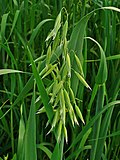 |
Avena sativa | 42[7] | Detta är en hexaploid med 2n = 6x = 42. Diploida och tetraploida odlade arter förekommer också.[källa behövs] |
| Vete |  |
Triticum aestivum | 42[7] | Detta är en hexaploid med 2n = 6x = 42. Durumvete är Triticum turgidum var. durum, och är en tetraploid med 2n = 4x = 28.[källa behövs] |
| Rhesusapa |  |
Macaca mulatta | 42[9] | |
| Delfin |  |
Delphinidae Delphi | 44 | |
| Europeisk kanin |  |
Oryctolagus cuniculus | 44 | |
| Europeisk grävling |  |
Meles meles | 44 | |
| Öronmanet |  |
Aurelia aurita | 44[10] | |
| Muntiacus reevesi |  |
Muntiacus reevesi | 46 | |
| Sabelantilop |  |
Hippotragus niger | 46 | |
| Människa |  |
Homo sapiens | 46[11] | 44 autosomala kromosomer och 2 könskromosomer. |
| Bävrar |  |
Castor fiber | 48 | |
| Hjortråttor |  |
Peromyscus maniculatus | 48 | |
| Gorillor |  |
Gorilla | 48 | |
| Harar[12][13] |  |
Lepus | 48 | |
| Orangutanger |  |
Pongo x | 48 | |
| Potatis | 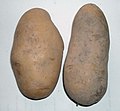 |
Solanum tuberosum | 48[7] | Detta är en tetraploid; vilka släktingar har mestadels 2n = 24.[källa behövs] |
| Tobak |  |
Nicotiana tabacum | 48[källa behövs] | Odlade arter är en tetraploid.[källa behövs] |
| Tallört |  |
Monotropa hypopitys | 48[7] | |
| Schimpanser |  |
Pan troglodytes | 48[14] | |
| Vattenbuffel |  |
Bubalus bubalis | 48/50 | Flodtypen har 48, medan träsktypen har 50. |
| Ökenkatträv |  |
Vulpes macrotis | 50 | |
| Strimmig skunk |  |
Mephitis mephitis | 50 | |
| Ananas |  |
Ananas comosus | 50[källa behövs] | |
| Zebrafisk |  |
Danio rerio | 50[15] | |
| Glasögonbjörn | 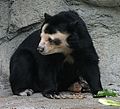 |
Tremarctos ornatus | 52 | |
| Näbbdjur |  |
Ornithorhynchus anatinus | 52[16] | 10 könskromosomer. |
| Bomull |  |
Gossypium hirsutum | 52[källa behövs] | |
| Tamfår |  |
Ovis orientalis aries | 54 | |
| Silkesfjäril |  |
Bombyx mori | 54 | |
| Hyraxar |  |
Hyracoidea | 54[17] | Hyraxar anses vara den närmaste levande släktingen till elefanter.[18] |
| Kapucinapor |  |
Cebus x | 54[19] | |
| Elefant |  |
Elephantidae | 56 | |
| Gaur |  |
Bos gaurus | 56 | |
| Glasbjörk |  |
Betula pubescens | 56[7] | |
| Ullhårig mammut |  |
Mammuthus primigenius | 58 | Utdöd; vävnad från en fryst slaktkropp. |
| Indisk räv |  |
Vulpes bengalensis | 60 | |
| Bisonoxe |  |
Bison bison | 60 | |
| Nötkreatur |  |
Bos primigenius | 60 | |
| Tamget |  |
Capra aegagrus hircus | 60 | |
| Yakoxe |  |
Bos mutus | 60 | |
| Åsna |  |
Equus africanus asinus | 62 | |
| Giraffer |  |
Giraffa camelopardalis | 62 | |
| Mula |  |
63 | Semiinfertila (udda antal kromosomer – mellan åsna (62) och häst (64) – gör meios mycket svårare). | |
| Myrpiggsvin |  |
Tachyglossidae | 63/64 | 63 (X1Y1X2Y2X3Y3X4Y4X5, hane) och 64 (X1X1X2X2X3X3X4X4X5X5, hona).[20] |
| Häst |  |
Equus ferus caballus | 64 | |
| Fläckskunkar |  |
Spilogale x | 64 | |
| Chinchillor |  |
Chinchilla lanigera | 64[21] | |
| Fennek |  |
Vulpes zerda | 64[källa behövs] | |
| Mårdhund |  |
Nyctereutes procyonoides | 66 | Viss variation i antalet kromosomer mellan individer.[22] |
| Gråräv |  |
Urocyon cinereoargenteus | 66[källa behövs] | |
| Gråvarg |  |
Canis lupus | 78 |
Källor
[redigera | redigera wikitext]- ^ Avarello; Pedicini, A; Caiulo, A; Zuffardi, O; Fraccaro, M (1992). ”Evidence for an ancestral alphoid domain on the long arm of human chromosome 2”. Human Genetics 89 (2): sid. 247–9. doi:. PMID 1587535.
- ^ Concise Oxford Dictionary
- ^ White 1973, s. 28.
- ^ Stebbins, G.L. (1950). ”Chapter XII: The Karyotype”. Variation and evolution in plants. Columbia University Press.
- ^ King, R.C.; Stansfield, W.D.; Mulligan, P.K. (2006). A dictionary of genetics (7th). Oxford University Press. Sid. 242.
- ^ [a b] Crosland, M.W.J., Crozier, R.H. (1986). ”Myrmecia pilosula, an ant with only one pair of chromosomes”. Science 231 (4743): sid. 1278. doi:. PMID 17839565. Bibcode: 1986Sci...231.1278C.
- ^ [a b c d e f g h i j k l m] Lid, Johannes (1963). Norsk og svensk flora (2:a uppl. 1979)
- ^ Rofe, R. H. (December 1978). ”G-banded chromosomes and the evolution of macropodidae”. Australian Mammalogy 2: sid. 50–63. ISSN 0310-0049. https://books.google.com/books?id=N_ifwszrgFsC&pg=PA53&lpg=PA53#v=onepage&q&f=false. Läst 15 juli 2011.
- ^ Moore, CM; Dunn, BG; McMahan, CA; Lane, MA; Roth, GS; Ingram, DK; Mattison, JA (2007). ”Effects of calorie restriction on chromosomal stability in rhesus monkeys (Macaca mulatta)”. Age (Dordr) 29: sid. 15–28. doi:. PMID 19424827.
- ^ Diupotex-Chong, Maria Esther; Ocaña-Luna, Alberto; Sánchez-Ramírez, Marina (July 2009). ”Chromosome analysis of Linné, 1758 (Scyphozoa: Ulmaridae), southern Gulf of Mexico”. Marine Biology Research 5 (4): sid. 399–403. doi:. http://www.tandfonline.com/doi/abs/10.1080/17451000802534907. Läst 7 oktober 2015.
- ^ ”Human Genome Project”. National Center for Biotechnology Information. http://www.ncbi.nlm.nih.gov/sites/entrez?db=genomeprj&cmd=Retrieve&dopt=Overview&list_uids=9558. Läst 29 april 2009.
- ^ T.J. Robinson; F. Yang; W.R. Harrison (2002). ”Chromosome painting refines the history of genome evolution in hares and rabbits (order Lagomorpha)”. Cytogenetic and Genome Research 96 (1-4): sid. 223–227. doi:. PMID 12438803. http://content.karger.com/ProdukteDB/produkte.asp?Aktion=ShowAbstract&ArtikelNr=63034&Ausgabe=228416&ProduktNr=224037.
- ^ Rabbits, Hares and Pikas. Status Survey and Conservation Action Plan. Sid. 61–94. Arkiverad från originalet den 2011-05-05. https://web.archive.org/web/20110505143212/http://wildlife1.wildlifeinformation.org/S/00Ref/BooksContents/b605.htm. Läst 18 maj 2017. Arkiverad 5 maj 2011 hämtat från the Wayback Machine. ”Arkiverade kopian”. Arkiverad från originalet den 5 maj 2011. https://web.archive.org/web/20110505143212/http://wildlife1.wildlifeinformation.org/s/00Ref/BooksContents/b605.htm. Läst 18 maj 2017.
- ^ ”Chromosome number of the chimpanzee, Pan troglodytes”. Science 131 (3414): sid. 1672–3. June 1960. doi:. PMID 13846659. Bibcode: 1960Sci...131.1672Y.
- ^ http://genome.cshlp.org/content/10/12/1890.long
- ^ Warren (2008). ”Genome analysis of the platypus reveals unique signatures of evolution”. Nature 453 (7192): sid. 175–183. doi:. PMID 18464734. PMC: 2803040. Bibcode: 2008Natur.453..175W. http://www.nature.com/nature/journal/v453/n7192/pdf/nature06936.pdf.
- ^ O'Brien, Stephen J., Meninger, Joan C., Nash, William G. (2006). Atlas of Mammalian Chromosomes. John Wiley & sons. Sid. 78. ISBN 978-0-471-35015-6.
- ^ "Hyrax: The Little Brother of the Elephant", Wildlife on One, BBC TV.
- ^ Barnabe, Renato Campanarut; Guimarães, Marcelo Alcindo de Barros Vaz; Oliveira, CláUdio Alvarenga de; Barnabe, Alexandre Hyppolito (2002). ”Analysis of some normal parameters of the spermiogram of captive capuchin monkeys (Cebus apella Linnaeus, 1758 )”. Brazilian Journal of Veterinary Research and Animal Science 39. doi:.
- ^ Rens, W. (2007). ”The multiple sex chromosomes of platypus and echidna are not completely identical and several share homology with the avian Z”. Genome Biology 8 (11): sid. R243. doi:. PMID 18021405. PMC: 2258203. http://genomebiology.com/2007/8/11/R243. Arkiverad 2 oktober 2015 hämtat från the Wayback Machine. ”Arkiverade kopian”. Arkiverad från originalet den 2 oktober 2015. https://web.archive.org/web/20151002060856/http://genomebiology.com/2007/8/11/R243. Läst 18 maj 2017.
- ^ ”Arkiverade kopian”. Arkiverad från originalet den 26 augusti 2011. https://web.archive.org/web/20110826021838/http://resources.metapress.com/pdf-preview.axd?code=3180kk1kk0873012&size=largest. Läst 29 juni 2010.
- ^ Måkinen, Auli (1986). ”A chromosome-banding study in the Finnish and the Japanese raccoon dog”. Hereditas 105: sid. 97–105. doi:. http://onlinelibrary.wiley.com/doi/10.1111/j.1601-5223.1986.tb00647.x/abstract.
Externa länkar
[redigera | redigera wikitext]- The dog through evolution (engelska)
- Shared synteny of human chromosome 17 loci in Canids (engelska)
- An atlas of the chromosome numbers in animals (1951); PDF downloads of each chapter (engelska)
- Bell, G. (1982). The Masterpiece of Nature: The Evolution and Genetics of Sexuality (University of California Press, Berkeley), p. 450, [1] (table with a compilation of haploid chromosome number of many algae and protozoa, in column "HAP").
- Nuismer, S.; Otto, S.P. (2004). ”Host-parasite interactions and the evolution of ploidy”. Proc. Natl. Acad. Sci. USA 101: sid. 11036–11039. doi:. (Supporting Data Set, with information on ploidy level and number of chromosomes of several protists)
